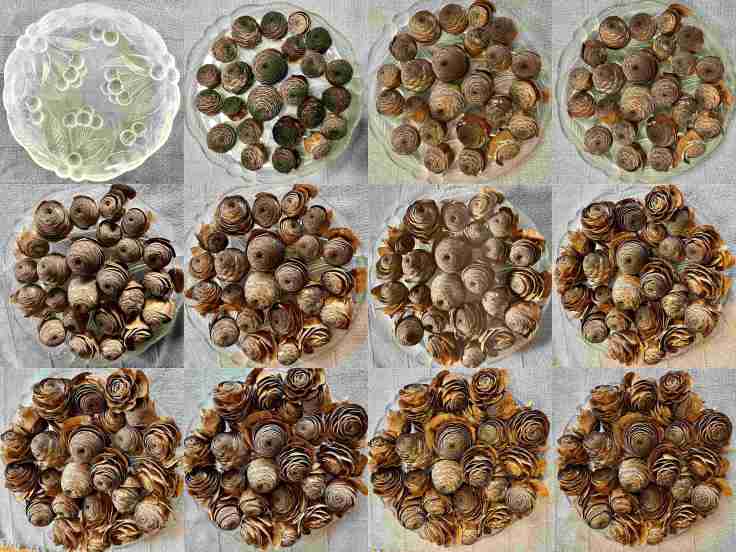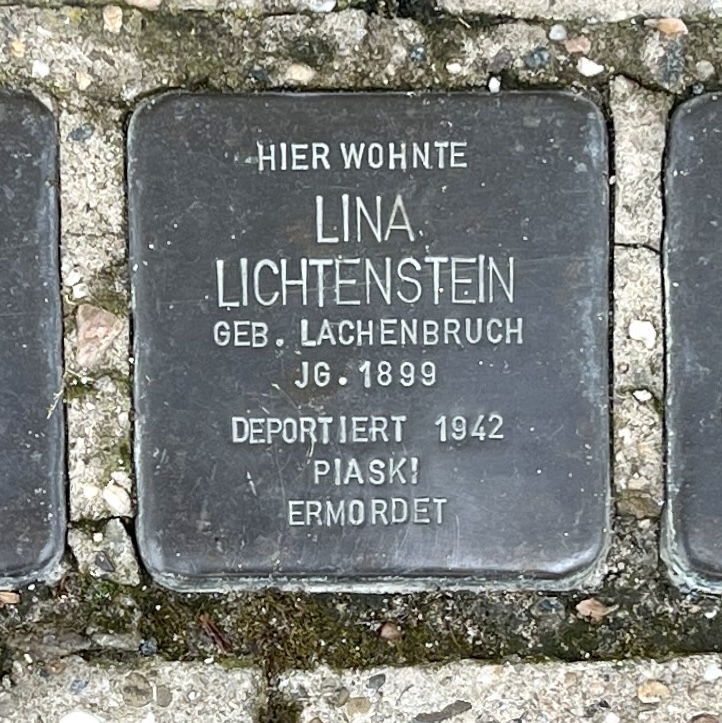
I leave home with it all figured out. I’m flying from Oregon to Germany to deal with some issues of my family roots. I’ve left a cake plate full of deodara cones on the dining room table. The squirrels had trimmed the cones up, and I thought they looked like cupcakes. I asked my husband to take a photo of them every day I was gone. The cones opened, rearranged themselves, and changed—and even though I can barely detect differences from day to day, the changes by the end are evident. A perfect analogy for me on my trip.
My cousin will come by train from France, where she lives, and meet me at the airport. Together, we’ll head to the town from which some of our relatives immigrated and where others stayed and were killed by Nazis. My cousin and I have each been heartbroken considering that family members were murdered and that no one was left to mourn them. If nothing else, we will accomplish that task.
But my thoughts don’t go the way I expected.
My first new thought:
The first morning that I wake up in our ancestral town, I do the math. Our direct ancestors left here 170 years ago—a very long time ago. And even though I knew my grandparents and knew many of their stories, I knew nothing of their parents or their parents’ parents who immigrated. There’s a direct line to my German past, but it’s a rather faded one.
And then the victims: I always considered them kin of some sort, but now I see how distant our kinship is. They were born, not to my ancestors, but to their siblings, cousins, and descendants of those siblings and cousins a generation or two after my ancestors immigrated. And these semi-kin, semi-strangers were murdered 80 years ago. My ancestors probably didn’t know them. Even people who knew them are mostly dead now. They’re not the closest of kin.
Then I look at my cousin across my second Milchkaffee and realize that even our relationship is indirect. Our grandparents were brothers. I hadn’t heard of her until college. We met, not through our parents, but by searching each other out when we were already adults and had kids of our own.

“Here lived Lina Lichtenstein,” reads a stolpersteine (stumbling stone) in our little town. “Born Lachenbruch. 1899. Deported 1942. Piaski. Murdered.” This monument is one of more than 45000 such brass plaques embedded in sidewalks throughout Europe in front of the last place a Nazi victim lived by choice. The last place Lina lived has been rebuilt into a stuccoed apartment with aluminum windows. Strangers live in the footprint of her former home.
A few doors down is the butcher shop, almost certainly the one my ancestors ran 180 years ago and that Lina and her husband took over from her parents in the 1920s. Jews couldn’t own farmland, so Butcher and Fruit Handler were among the few careers they could have. On April 17, 1939, three years before Lina and her husband’s deaths, they sold their family shop so they could immigrate. I doubt the sale was by choice or at a good price. I wonder—does today’s owner worry that a Lachenbruch will return some day and ask, “How did you get that butcher shop—seriously, tell me: how did you get that butcher shop?” Probably not. In any case, we aren’t able to meet her; she’s elderly, and it’s her naptime when we go by.
So we walk two short blocks down a road that comes to an awkward dead end. The second-from-the-last house is a small two-story, not counting the attic which is vented by a Star of David carved through the walls. This house was the synagogue. After Lina and her husband sold their shop and sent their children, 7 and 10, off to someone in Darmstadt, they climbed into the attic of this synagogue and hid for almost three years. In 1942, the family was reunited and transported to an overcrowded ghetto in Piaski, Poland. None of them survived. To think that someone lives—makes a home—in the synagogue where Lina worshipped and hid for her life.
My second new thought:
That people occupy Lina’s former home and synagogue makes me angry. How can they live with themselves, taking those spaces?
My cousin and I continue our education by visiting with three sets of historians. One tells us that 15,000 Jews were killed or fled from this region—and that only one, a man in love with a non-Jew, returned. Afterward, other Germans backfilled the spaces left by the 14,999 people who never returned.
Business as usual after killing one’s fellow citizens? Seriously? That’s so sad. But what would I expect people to do with that empty space? The killed and deported were not coming back. Using it makes sense.
My third new thought, not one I expected at all:
The government of my country passed legislation that encouraged settlement. Early homesteaders “acquired” land and developed towns. My house, built in 1904, was the first such structure on our lot.
But that land—my land—is someone else’s homeland. I live near the confluence of two rivers. In 1830, ten years before my ancestors left Germany, 9,000 Kalapuya People occupied this confluence for parts of the year. By 1887, those who survived were forced into reservations. That’s the same year my grandfather was born, a time I’ve already claimed I am connected to. That theft was not so very long ago.
I, too, live on stolen land.*
My fourth new thought, from which I’m even less able to conclude:
The trip is nearing its end. My cousin and I visit our town’s folk museum where local history is archived and displayed. We mention Lina to the historian who is our museum guide. In an anguished voice, she says (I paraphrase), “We were just country people. My parents certainly would have known and done business with the Lachenbruchs for generations. But like everyone out here in the country, my parents lived isolated lives. There were no emails or newspapers or phones to give anyone accurate information on what was happening. My parents would have hoped the Lachenbruchs and all the others found ways to escape.” Her voice becomes quieter. “But they hadn’t gotten out. We learned that later.”
I have sympathy for her parents, and yet. And yet.
Someone must have supplied Lina with food and other needs during those years in hiding. Thank you, whoever that was for that. And yet.
Now the museum guide shows us the display on World War II. “This,” she says, “is about all the people from our town who died during the war.” It’s a set of posters ganged together on a central axis. My cousin and I flip through them so we can see the photos of the 120 soldiers who died—a sizeable number for a town of 1,200. But the display has no mention of the Jews.
OK. An oversight, made by humans. Being angry won’t help much.
And a way forward:
We’re in the airport again, my cousin to take the train back to France and me to fly back to Oregon. We aren’t so distant anymore. This trip has made us sisters. Before our third goodbye hug, we cook up a plan. We’ll find as much information as possible, then draft a poster about the other town victims of World War II. We can send our poster, requesting that the museum add it to the display. My cousin and I laugh, imagining a half-dozen historians getting together to discuss our request. “That,” my cousin belly-laughs, “would be a start.”
And I’m thinking, let them get busy editing it, re-sizing it, putting it up. After all, that’s what my cousin and I have done with the history we’ve taken in on this trip. That’s what I’ve done with living on stolen lands in my Oregon home. That’s what humans do to go on living day in and day out.
And I’m also thinking that how I—and other humans—choose to deal with the past is paramount. Although the world is shaped by history, it changes through the trends the survivors put in place.
When I’ve been home for three months, I put my hands in the cake plate and swirl the deodara cones around, putting scales next to scales they never knew, spilling seeds and membranes to locations where they never spilled before. I will toss the cones. But I must never toss the trends I contribute to. Because these initiatives—as well as the ill ones I permit, tolerate, and do not work to block—are the portals of tomorrow’s history.

Hi Barb
A very sad time for the Lachenbruch family , a journey of history and sadness for you Barb and your cousin
LikeLike
Thank you. I’ve learned a lot on the journey.
LikeLike
I am touched by your emotional honesty. Thank you.
These issues are complex, multidimensional and can lead to troubling positions.
We do our best, yet we still are indirectly responsible for suffering and injustice.
At least we’re not as ruthless and destructive as a eucalyptus tree!
LikeLike
Thanks! We’re as invasive though (haha).
LikeLike
Thank you. My roots are from very young orphaned German brothers, John and Jacob Schoenberger who landed in Pittsburg three or four generations ago. Your story has triggered so many thoughts. Powerful, tragic. Enlightening. Sad. Beautiful, and more
LikeLike
Thank you. It’s so complicated. At times I thought the past was so far away I needed to entirely move on, but I don’t think so.
LikeLike
Failed to add attribution to my comment about my mother’s grandfather Schoenberger
LikeLiked by 1 person
Barb, I am so glad I subscribe to your blog. Your essays are provocative, insightful and beautifully crafted. Thank you for sharing your writing! Jana Kay Slater (from the writing group)
>
LikeLike
Thanks, Jana Kay. If you’re up for talking about this and everything else we talked about, I’d love to get together some time!
LikeLike
From Bob Rhudy, my oldest brother: “Barb, I loved your entire article, including your analogy to how we treated our Indigenous peoples.”
LikeLike
Thanks, Barb, for including me
LikeLike
Barb, Just catching up on email, and found your moving post. Given my own family history in Austria, some of the questions and dilemmas sound familiar. The current generation, temporally removed from the events in question, seems more open to looking at the events and people’s choices than the immediate post-war generation. At least it’s a start and a warning. -Flora
LikeLike
Just found this!
<
div>
Looking forward to reading it!
<
div>L
Sent from my iPhone
<
div dir=”ltr”>
<
blockquote type=”cite”>
LikeLike
No, not at all.
Will try to remember to give a reminder next time. I’ve noticed that you often do a day-of confirmation, so I should be suspicious of “calendar fail” when I don’t get one from you.
Jennifer D. Munro
LikeLike